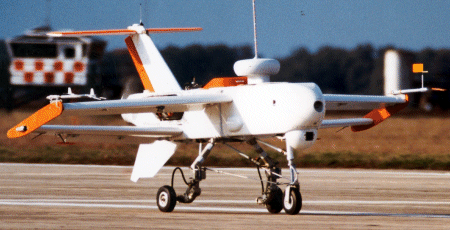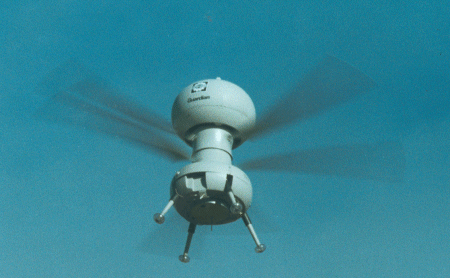Sea trials are on the horizon for VTOL unmanned air vehicles
Ramon Lopez/WASHINGTON DC
Expectations are rising that naval forces will soon be able to field vertical take-off and landing (VTOL) unmanned air vehicles (UAVs) now that technical problems that have hampered development of sea-based UAVs show signs of being overcome.
Optimism has been fuelled by the US Department of Defense's (DoD) successful 50h VTOL UAV demonstration at the Yuma proving grounds in Arizona last year. The land-based flight tests are to be followed by critical sea trials next month.

Bell, with its Eagle Eye tiltrotor, and Bombardier, with the CL-327 Guardian co-axial rotor UAV, will take part in the shipborne flight operations. Both companies - among others - hope the demonstration will lead to lucrative production contracts from the US military and other armed forces. Making this possible was the Pentagon's decision last year to allow the US Navy and Marine Corps to leave the trouble-plagued Alliant Techsystems Outrider Joint Tactical UAV (JTUAV) project (above) and switch to a rotary-wing design. The US Army is conducting a fly-off between off-the-shelf tactical UAVs to find a system to satisfy its close-range TUAV needs.
The launching of a VTOL procurement for US naval forces comes as UAVs are attracting the attention of other navies - there is a NATO Staff Requirement for a maritime unmanned air vehicle (MUAV) system. After being delayed by more than a year, a key MUAV demonstration, intended to form the basis of a collaborative development by NATO member countries, is set to get under way this month.
The Pentagon's VTOL UAV sea trials will be taking place as acquisition activities build steam. The Navy UAV Programme Office is ready to issue a VTOL Tactical UAV (VTUAV) draft request for proposals this month and the final version in August.
Engineering and manufacturing development (EMD) will start next year, and low-rate initial production of two VTUAV systems and operational testing is set for fiscal year 2002. Initial VTUAV fielding is scheduled for the fourth quarter of FY2003, with full operational capability two years later.
The operational requirement document (ORD) for the VTUAV calls for procurement of 12 systems for the USN and 11 for the USMC, to replace Pioneer UAVs. Each VTUAV system will include four air vehicles with payload (electro-optical/infrared sensor with laser designator) and two tactical control stations (TCS), under development.
VTUAV procurement in the USA could grow to 56 systems - worth $1.3 billion - in the unlikely event that the USN can find the funding to give its fleet commanders the 33 additional VTUAV systems they want.
US naval forces have coveted VTOL UAVs for some time and the VTUAV ORD updates a requirements document that was shelved in 1992 because of a funding shortfall.
Two years ago, however, the US Congress asked the USN to evaluate the maturity of VTOL UAV technologies, concentrating on air vehicle performance. Congressional backers of the CL-327 Guardian added $15 million to the DoD's 1997 budget to test the vehicle. The Program Executive Office Cruise Missiles and Joint Unmanned Aerial Vehicles (PEO/CU) won permission to conduct competitive land-based trials of the Williams International WTS-117 turboshaft-powered CL-327, the Eagle Eye tiltrotor - powered by an Allison 250-C20 turboshaft - and the Science Applications International (SAIC) Vigilante demonstrator, built around the US SportCopter Ultrasport 496 design, a small kit-built helicopter (below).

The lawmakers subsequently earmarked additional cash, and the USN redirected funds to conduct the VTOL UAV sea trials and launch a VTUAV procurement. The USN plans to spend $141million between 2000 and 2003 (beginning with $39 million in 2000) for research and development, and has earmarked $161 million between 2003 and 2005 to begin UAV system production.
SAIC suffered technical problems at Yuma, leading the USN to exercise $5 million contract options last July with only Bombardier and Bell for the integration of their air vehicles with the Sierra Research UAV Common Automated Recovery System (UCARS) for separate land-based and shipboard trials beginning this year.
USN Capt Lyn Whitmer, programme manager for naval UAVs, says there is no hitch with the UCARS integration work, and he expects Guardian testing to get under way in June-July on board the USS Boone FFG-7 Perry class frigate, or possibly a US Coast Guard cutter. Bell will get its turn next February, probably aboard a USN destroyer. The USCG wants to evaluate VTOL UAVs for drug interdiction missions as part of its Integrated Deepwater Systems Capability Replacement Project - known simply as Deepwater. Whitmer says observation of the sea trials will help the USCG determine whether UAVs will be able to spot drug runners. "We understand their needs," and "we want to help," he says of the USCG.
Also coming aboard the US maritime UAV demonstration is the UK, which will test one of two TCS being acquired from the Pentagon through foreign military sales channels. The TCS will not be used to control the UAVs - it will simply receive UAV payload data.
UK participation will help determine its needs for a maritime reconnaissance system. Meanwhile, the UK is funding a study to define what is required for full function and control of VTOL UAV take-off and landing. The UK's involvement is part of a restructuring of its role in the NATO trilateral MUAV project.
The USN ORD requires the VTUAV to be TCS-compliant and have a 3h endurance and 204km (110nm) range. Incorporation of a powerplant that can burn JP-5/8 jet fuel is a so-called key performance parameter (KPP). The threshold dash speed must be135kt (250km/h), but the USN wants 200kt.
Whitmer says the USN will decide soon on one of three acquisition strategies being considered - a quick direct shortlist to one EMD contractor; EMD for the company that wins an initial six-month competitive design effort among up to three bidders; and a more costly, competitive, prototype fly-off between at least two TUAV systems, which would delay their introduction by at least two years.
Whitmer says a TUAV system cost target will be set by August "to focus on the total cost of ownership". Cost may also affect the initial payload: a market survey shows that only the USMC Bell AH-1Z attack helicopter's Lockheed Martin-developed Target Sight System may comply with the ORD specifications. He says the requirement could be relaxed. He is "confident" there will be additional TUAV payloads once funding is found.
USN Rear Adm Jack Chenevey, head of the PEO/CU, says the VTUAV project is "very significant. Technically, we're close to fielding an operational VTOL UAV-this is the start of a new generation of UAVs for the USN and USMC."
The VTUAV contest has drawn at least 10 bidders, including Bell, SAIC, a Bombardier/Raytheon team, a team comprising Schweizer Aircraft and Northrop Grumman, and even the UK's Intora Firebird with a vehicle fuelled by hydrogen peroxide.
The Firebird's main rotor is propelled by rocket engines fitted on the end of each rotor blade. A gas mixture is ejected through a nozzle, creating thrust to power the blades.
Sikorsky, Freewing and Scheibel are also believed to have responded to the VTUAV request for information (RFI). Boeing, meanwhile, may team with a foreign partner or propose to resurrect its Heliwing UAV design.

Easy for Eagle Eye
Bell's Eagle Eye qualifies easily, and Bombardier believes it can compete with the Guardian (above) or the in-development CL-427 Puma, which have top speeds of 85kt and 120kt, respectively. The Canadian company is seeking reassurances that the dash speed issue will not penalise its chances of winning the contest. It believes its link-up with Raytheon, the major US defence contractor that won the TCS production contract, makes its bid even more solid.
Meanwhile, the Northrop Grumman/ Schweizer team is offering an unmanned derivative of the Schweizer 300CB single-piston light helicopter, known as the RoboCopter 300. SAIC believes it has solved flight control system problems which kept it out of the VTUAV sea trials. Both competitors plan to switch to heavy fuel engines. The ground rules would have to be changed for the Intora-Firebird to compete, but Whitmer "sees no move to change the KPP".
Germany's DaimlerChrysler Aerospace (Dasa) did not answer the RFI. Dasa's Seamos VTOL naval UAV is a key element of NATO Project Group 35's trilateral international technology demonstrator project, but the German company has suffered problems with the autopilot and navigation systems, delaying an initial land-based Seamos/TCS tethered test scheduled for April last year.
USN Capt Michael Witte, TCS programme manager and PG35 chairman, has sent a TCS to Germany now that an upgraded Seamos is flying with extended-range flight-guidance software, a proven hybrid navigation system from Honeywell and an Allison 250-C20 engine. This month's long-awaited tethered test will be followed by land-based flight tests in 2002 and sea trials.
Witte says PG35's UAV efforts are moving on, despite past setbacks. "PG35 is a good forum to discuss interoperability issues. We're making progress."
Source: Flight International























